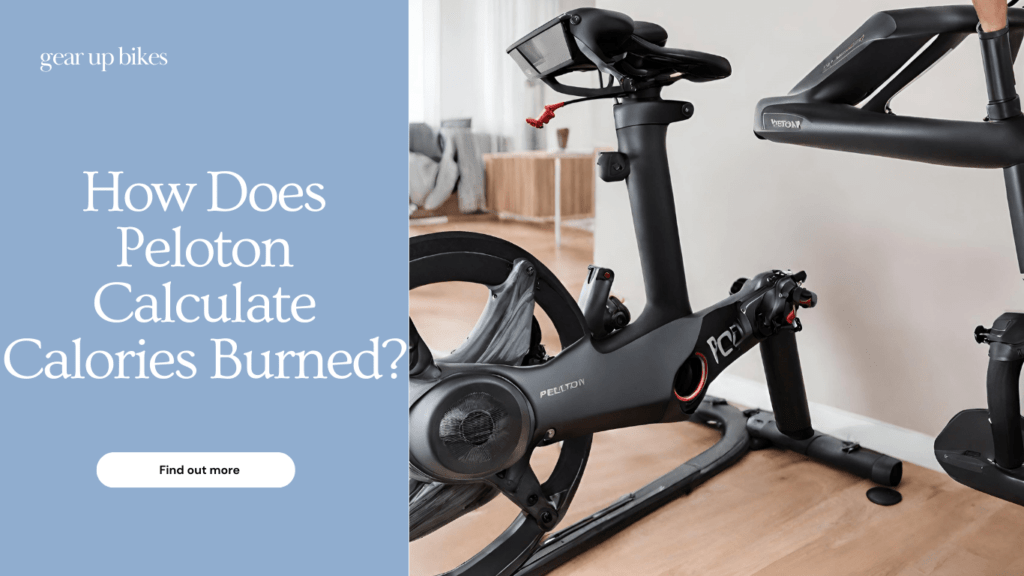
Tracking the calories burned during a workout is more than just a number; it’s pivotal for individuals aiming at weight loss or meeting their fitness goals. Enter Peloton, the renowned fitness brand that has revolutionized home workouts with its innovative exercise equipment and engaging classes.
Its surge in popularity among fitness enthusiasts can largely be attributed to its calorie burn algorithm, a new cut in the fitness world. This blog aims to delve into the intricacies of how Peloton calculates the calories burned, scrutinizing the accuracy of these calculations and uncovering the factors that influence the number of calories you torch in each session.
Table of Contents
How Does Peloton Calculate Calories Burned?

Peloton employs a highly precise algorithm to estimate the calories burned during your workouts. This algorithm is tailored to your unique personal factors like age, gender, weight, and the intensity of your workout. It intricately generates an approximate calorie burn value, relying on established metabolic equations to provide a tailored fitness insight.
Healthline supports the notion that an accurate calculation of calories burned is pivotal, and Peloton achieves this through integration with heart rate monitors. Connecting your monitor to the Peloton bike or app measures your heart rate, which indicates how hard you’re working. This real-time data enables precise estimation of your effort, allowing Peloton to adjust the calorie burn calculation to match your body’s exertion levels throughout the workout.
Are Peloton Calories Burned Accurate?
While Peloton strives to provide the most accurate calorie burn calculations possible, it’s essential to understand that these figures are, at their core, estimations. The accuracy of these numbers can vary significantly depending on a host of individual factors and the inherent limitations of any calorie calculation method. These limitations include that calorie burn is influenced by factors that are difficult to measure precisely, such as the efficiency of your body’s energy systems and the impact of non-exercise activities on your overall energy expenditure.
Recognizing this helps set realistic expectations and fosters a more informed approach to interpreting Peloton’s data. For example, if you notice that you’re consistently burning fewer calories than you expected, it might be a sign that you need to increase the intensity of your workouts. On the other hand, if you’re consistently burning more calories, it could mean that you’re pushing yourself too hard and need to dial back. This understanding can guide users toward a more nuanced understanding of their fitness journey.
Factors Influencing Calorie Burn on Peloton

The Individual Equation
Each of us possesses a unique physiology that plays a significant role in the calorie burn during a workout. For instance, a person with a higher muscle mass might burn more calories than someone with a lower muscle mass, even if they’re doing the same Peloton workout. Similarly, a person with a faster metabolism might burn calories more quickly. These factors, along with others like body composition and overall fitness level, can profoundly influence the number of calories burned. It’s fascinating how two people performing the same Peloton workout might experience slightly different calorie burn results, a testament to our complexities.
Powering Through with Intensity
The intensity of your workout is a pivotal determinant of calorie burn, a principle Peloton masterfully applies across its wide range of classes. From low-impact rides to high-intensity interval training (HIIT) sessions, each workout is designed to engage various muscle groups with varied intensity levels. The more intense the session, the higher the calorie burn, offering a clear path for those aiming to maximize their efforts. By opting for challenging classes that push your limits, you enhance your fitness level and significantly increase your calorie expenditure, making every drop of sweat beneficial.
Time vs. Intensity
The duration of your Peloton workout significantly affects the number of calories burned. A more extended workout leads to a higher calorie burn, but balancing duration and intensity is essential. While longer rides may burn more calories, shorter, high-intensity sessions can also significantly burn calories due to the increased effort exerted. This highlights the importance of matching workout length with intensity to maximize calorie-burning efficiency, ensuring every minute spent is a step towards your fitness goals.
Tuning Your Ride
Adjusting resistance levels and cadence throughout your session is pivotal in the calorie burn equation in Peloton workouts. Engaging in a ride with higher resistance and a faster cadence demands more effort and engagement from your muscles and significantly increases your calorie burn. It’s crucial to embrace the challenge by gradually increasing resistance and maintaining an appropriate cadence, as this strategic approach can dramatically optimize your calorie-burn potential, turning each pedal stroke into a more effective calorie-torching movement.
Tuning into Your Heart’s Rhythm
Heart rate is a crucial component in estimating calorie burn within the Peloton ecosystem. The seamless integration with heart rate monitors ensures a more accurate calculation of calories burned by keeping track of your pulse during workouts. This data allows Peloton to gauge the intensity of your exercise and adjust calorie burn estimations accordingly. Maintaining a target heart rate zone, as recommended by fitness professionals, is key to maximizing your calorie burn and achieving overall fitness gains, making every beat count towards your health and fitness objectives.
you can also consider :How to Use Peloton Bike Without Subscription
Final words
Peloton’s calorie burn feature is undeniably valuable in tracking progress and achieving fitness goals. However, it’s crucial to recognize that these calculations and estimations are based on established algorithms and heart rate monitoring, and individual factors like physiology, workout intensity, duration, resistance, and heart rate can sway their accuracy.
But the essence of your fitness journey shouldn’t be tethered solely to calories burned. It’s essential to focus on overall health and well-being. Peloton offers an immersive experience through its workouts, engaging classes, and a supportive community that fosters an environment that encourages progress and drive. By combining the enjoyment of Peloton workouts with a healthy diet and a consistent exercise routine, you position yourself to meet and surpass your fitness aspirations.
Frequently Asked Questions
How does Peloton calculate the calories I burn during a workout?
Peloton uses a sophisticated algorithm that considers your age, weight, heart rate, workout intensity, and duration to estimate the calories you burn during each session.
Can I trust the accuracy of Peloton’s calorie burn estimation?
While Peloton’s calorie burn estimations are based on established algorithms and are generally reliable, they are still estimations. Individual physiology, fitness levels, and workout specifics can influence the accuracy of these calculations.
How can I ensure a more accurate calorie burn reading on my Peloton?
For more accurate readings, ensure your Peloton profile is updated with your current weight and age, use a heart rate monitor during workouts, and maintain proper form and intensity as guided by the instructors.
Why might there be discrepancies in calorie burn between my Peloton workout and other fitness trackers?
Discrepancies can occur due to differences in algorithms, sensors, and the specific data points each system uses to estimate calorie burn, including how each device measures workout intensity, duration, and individual biometrics.
What other metrics should I focus on besides calorie burn during my Peloton workouts to gauge my fitness progress?
Besides calorie burn, consider tracking your workout frequency, intensity levels, resistance settings, heart rate zones, and overall performance improvements in specific classes or workouts to get a holistic view of your fitness progress.
3 thoughts on “5 Powerful Insights: How Peloton Precisely Calculates Your Calorie Burn”